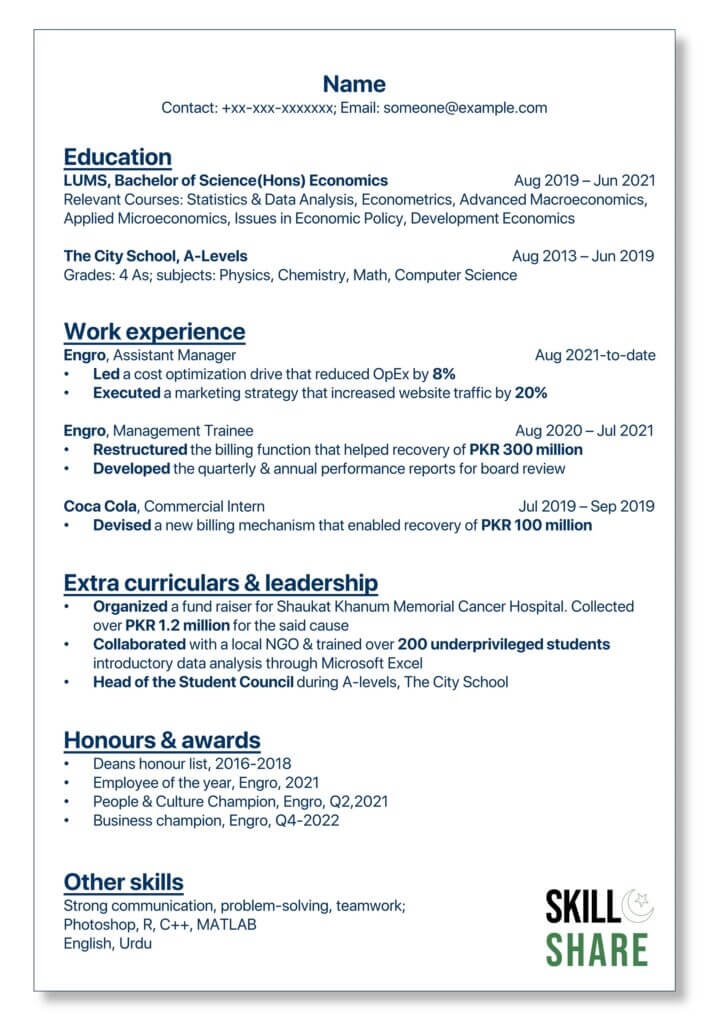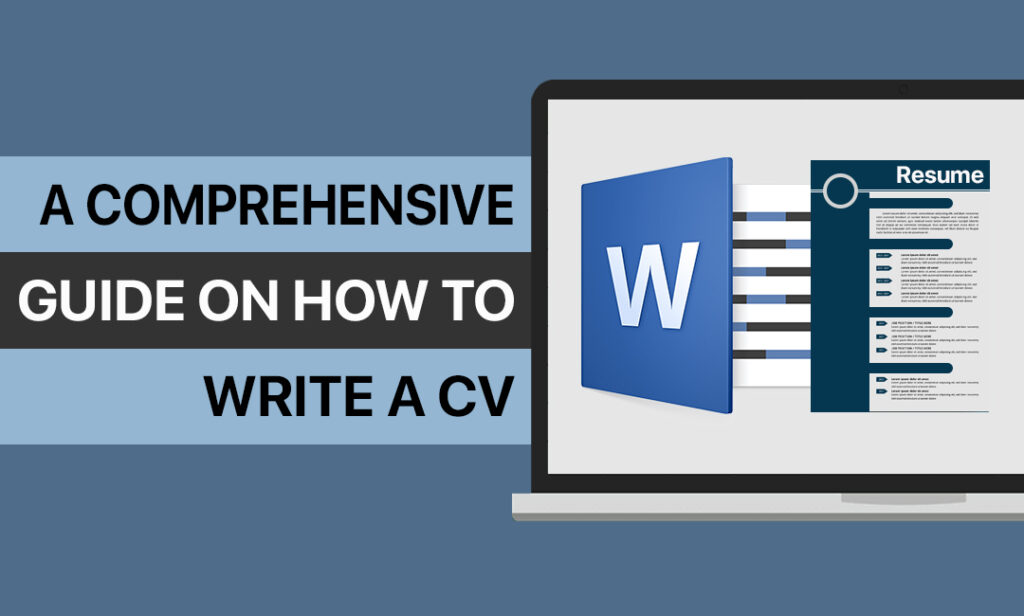To start off your career right, you need to get a job in the first place, and the first step of getting the job is getting your application material right, specifically your CV (curriculum vitae) and the cover letter. In this article, we are going to focus on CVs for job applications.
For this article, we are going to proceed in the following way; first, we will discuss the most important concepts that should be followed when you write a CV. This will give you some general points and remarks on how you can structure your CV to make it stronger and more effective. Next, we will look at sample CV templates & review a sample CV. We will go in-depth and in detail and make observations, and highlight how the applicant has adopted the principles of this CV writing guide in the sample CV template. This will give you a lot of insights about things that you should be careful about when you create your CVs.
How to write a CV: Introduction
Before we start off, let us first clear out that the things that we will discuss, critique, and give feedback on are our points of view and our opinions. We do not claim that we know every truth about what a perfect CV looks like or the best format for writing a CV. However, my insights will help you make valuable additions and improvements to your CV and will help you get your CV right for high-profile jobs.
In addition, always remember to take every piece of advice with a grain of salt. While the content of this article is widely considered among the best practices for writing a CV, it’s important that you are comfortable with your application material; therefore, if you have a good reason to deviate from what I’ll be covering in this article, then of course, do so. That said, let’s get right to it.
How to write a CV: CV Length
One thing that we would strongly recommend is having a one-page CV. A one-page CV is much easier to read and comprehend than one that goes over a single page. In most big firms, one-page CVs are the standard, they are the norm, and you really should apply with a one-page CV.
Typically, a recruiter has hundreds of CVs to go over for a single position, and, in most cases, they would not spend more than 45–60 seconds on a single CV. Therefore, it is imperative that you make all the valuable information available to them at a single glance. Keeping that in mind, we highly encourage applicants to make sure they limit the size of their CV to a single page. Moreover, a one-page CV just looks much more professional, and it’s easier to communicate yourself on a single page.
Of course, you can send in CVs that are two pages long, but you should never go over two pages. Though, again, it is ideal that you restrict yourself to a single page while writing your CV. Later in the post, I’ll show you an example and provide some tips and ideas on how to condense longer CVs into a single page.
In addition, always remember to take every piece of advice with a grain of salt. While the content of this article is widely considered among the best practices for writing a CV, it’s important that you are comfortable with your application material; therefore, if you have a good reason to deviate from what I’ll be covering in this article, then of course, do so. That said, let’s get right to it.
How to write a CV: CV Structure
Let’s now look at the structure of your CV. we will break down different sections of the CV into blocks. Ideally, your CV should have 3 main blocks, and each block can have minor sections.
There are four major content blocks and two minor content blocks in the proposal that we will present here. The main sections include personal information, education information, professional experiences, and finally, your honours and awards. For the minor content section, you can add some of the other volunteer projects you’ve worked on and, finally, some additional skills that you have or the tools and software that you are knowledgeable about. We will get to an example of a CV template later, but before that, remember that there is no ‘best CV template’. Everyone can have a different CV format, which is fine, as long as you keep in mind the main fundamentals of CV writing.
If you follow such a structure, you will hopefully cover all there is to know about you, and the recruiter will have a good picture of who you are, what you’ve worked on, and what you’ve achieved so far.
Sample CV template
If you look at our CV format, you’ll realize this is a very simple and professional CV template. At the very top of this CV, you have your personal information, followed by your educational history and credentials. Next, you will add your professional work experience, which is the most important section of your CV. You can also include a section for projects where you highlight the projects that you worked on, either during your academic years or in your personal capacity. After that, you will mention your awards, honours and other volunteering experiences. And finally, you will include some other skills that you have and tools that you know about, just to add some more flavour to your CV.
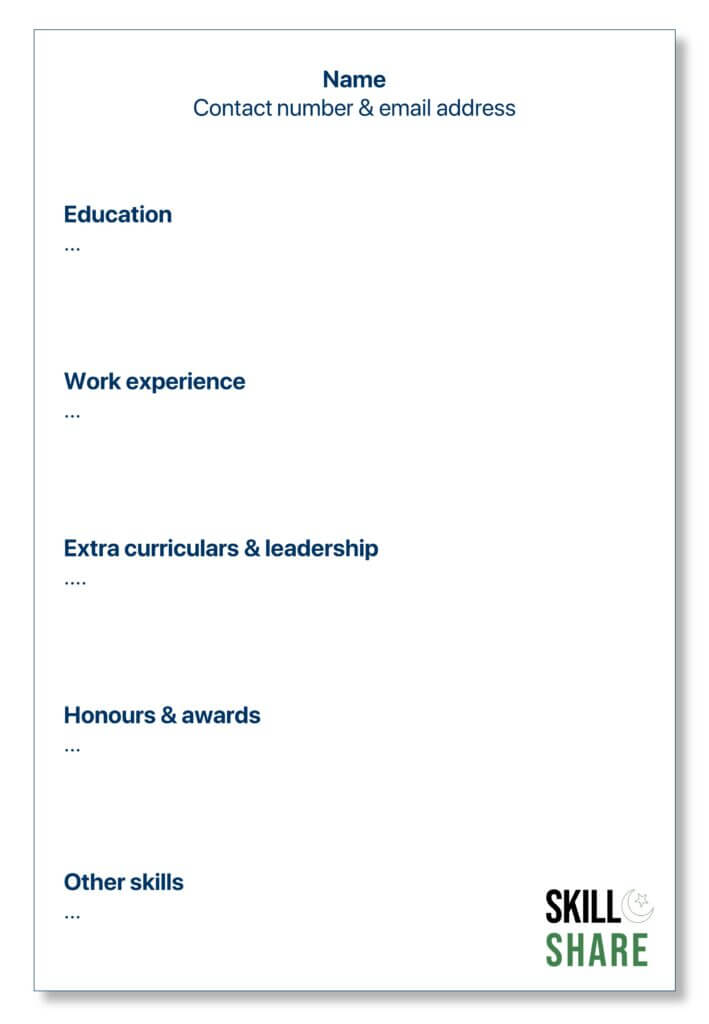
How to write a CV: Personal Information
The first section of the CV contains your personal information, which includes your name, your contact information, your address, your email, and your telephone number. This section will make it easier for the company to contact you without needing to look up other application materials of yours.
For this section, do not utilize too much space in the CV. Write your name on the top, and the rest of the details can be captured and placed in a single line; one after the other.
Refer to our sample CV template for clarity.
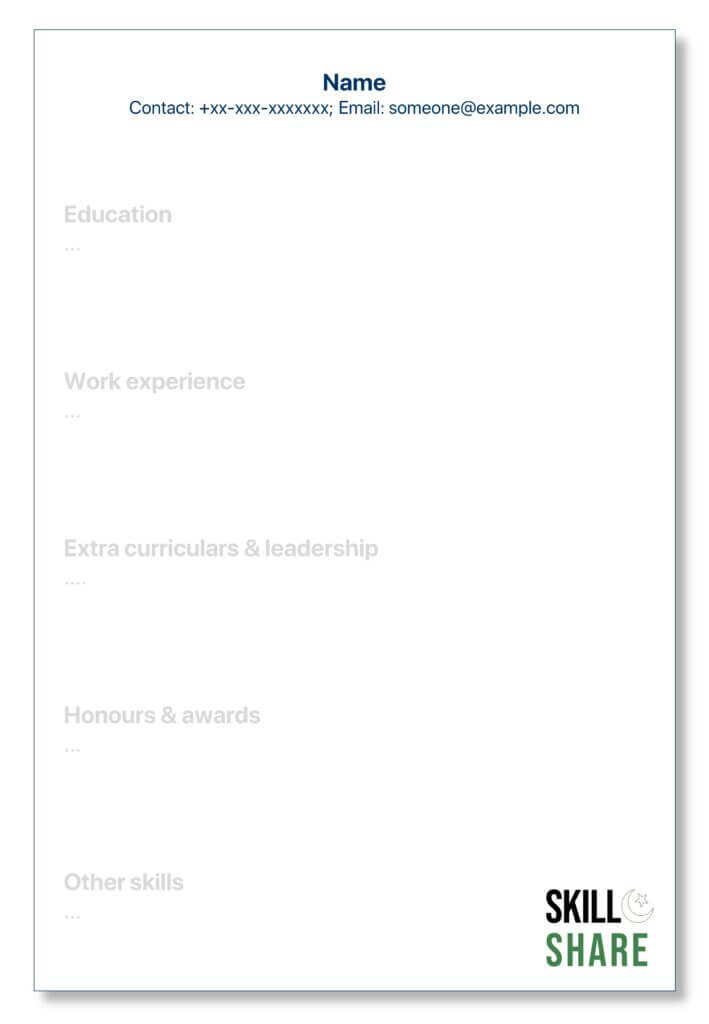
How to write a CV: Education
In the education section, list down your education history, your credentials, the degrees that you have collected, and the universities that you attended. So when you write a CV, follow an anti-chronological order: which means that the most recent experience will be mentioned first. Moreover, while presenting your educational history, mention some of the details of each experience or degree. In this case, mention the name of the university, the program name, the time period during which you took this degree, and lastly, your grade.
Keep a few points in mind when you write a CV:
Highlight your area of specialization. Mention your majors or the field of your studies. If you are applying for a specific job, you should tailor your CV to fit the job description mentioned in the position. For instance, if you are applying for a programming role, you can mention your area of specialization and the relevant courses that you took over the course of your degree, which can show the recruiter that you have the necessary credentials for this job.
In addition to your area of specialization, it is also helpful to mention your grades (GPA) on the CV. However, only mention your scores if they are good and worth putting on the CV. Nevertheless, there are ways to make your grades look more impactful:
Whenever it makes sense, mention the percentile of your grade. So, for example, a GPA of 3.0 (on a scale of 4.0) is perhaps not the best. However, there is a chance that you are studying a difficult course where GPAs are generally low. Maybe you’re in the top 10% or 15% of the class with this grade, and this, of course, will be highly beneficial to write about on your CV.
Next, if you have written a thesis for your bachelor’s or master’s degree and have achieved a grade that is significantly better than your course GPA, then add that in brackets in front of your normal GPA.
Finally, if you have studied on an exchange programme or have gone on an exchange semester, just mention this in one line and do not take up too much space while writing it on your CV. Use a greater amount of space to write in more detail about what you did or achieved in your main degree.
See our sample CV template below to get an idea of how to write a CV:
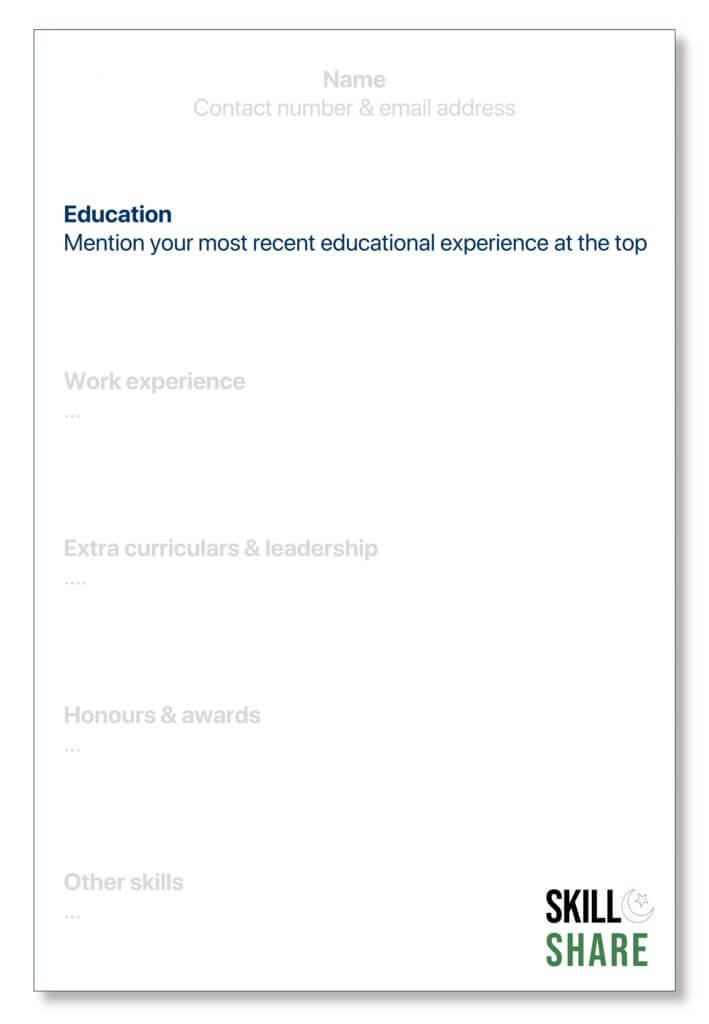
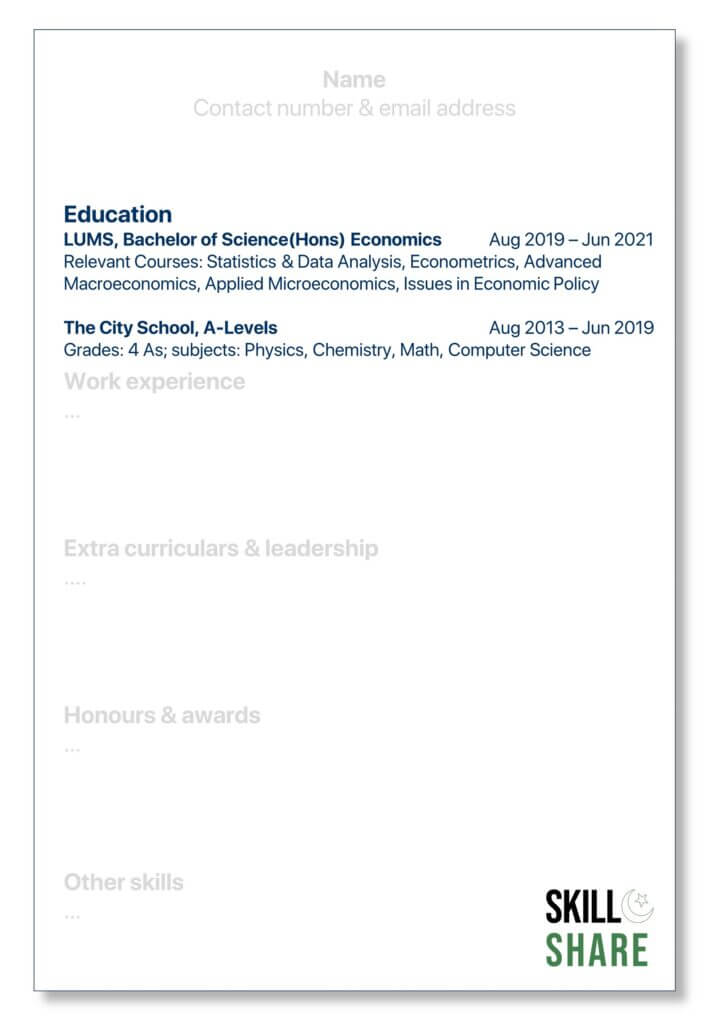
How to write a CV: Professional Experience
The section on professional experience is the most important section while writing the CV. In this section, you will write about your job experiences, which can include your full-time positions, your internships, your freelance work, and so on. Once again, follow an anti-chronological order with your latest job experience at the top.
Here, first, you will mention the name of the company that you worked at, followed by your job title. This will give the reader an idea of your responsibilities at the job. Along with this, you will also mention the period for which you worked in this position. In addition, mention your role at the job in the form of bullet points. We will cover this in detail ahead.
While you make a CV, we would encourage you to use parallel grammar structures whenever possible. This means that you use the same verb form throughout your CV. Moreover, we would advice you to start your sentence with a verb, as this emphasizes what you did in that position, and this is something that is going to create an impact on the CV.
For instance, you can start your sentence in the following way:
- Led a team of…
- Executed a new marketing strategy…
- Designed an application that was used…
If you have bullets that are written with parallel grammar structure, they will be much easier to read and understand and will give your CV a much more professional look.
Next, you will detail what you did in your role. This is going to be the most crucial part of writing a CV. To write an impactful CV, you have to make sure that you don’t simply mention your role or what you did, but rather highlight the impact that you created in this role. So, therefore, emphasize the impact & highlight your accomplishments, and not just as a team but specifically what YOUR contribution was towards the project.
Furthermore, instead of using general buzzwords to describe your role at a superficial level, say exactly and specifically what you did and what your impact was. Finally, whenever possible, quantify the impact. This will really make your CV look more impressive, and the recruiter will know precisely what you achieved or contributed. Here’s an example:
- led a team of 25 members and oversaw the deployment of over 1500 telecom sites
- Executed a new marketing strategy that improved conversion rate by 15%
- Designed an application that was used by over 2500 employees & increased workflow efficiency by 10%
Hence, quantifying your accomplishments will help you add a bit more flavour to your CV: it will clearly highlight the impact that you created and this is really what will distinguish a strong framing of work experience from a weak one
Another important point to remember while writing a CV is that you do not need to give every section equal weight or space. If there is work experience that is less relevant or less impressive, just give it less space on the CV. Instead, give more space in your CV to the things that are really important and relevant and less space to the things that are less relevant. Additionally, at some point, you will have collected more internships and job experiences. So in that case, you can also start dropping less important positions, as you do not need to list down every single work experience. See the sample CV format below:
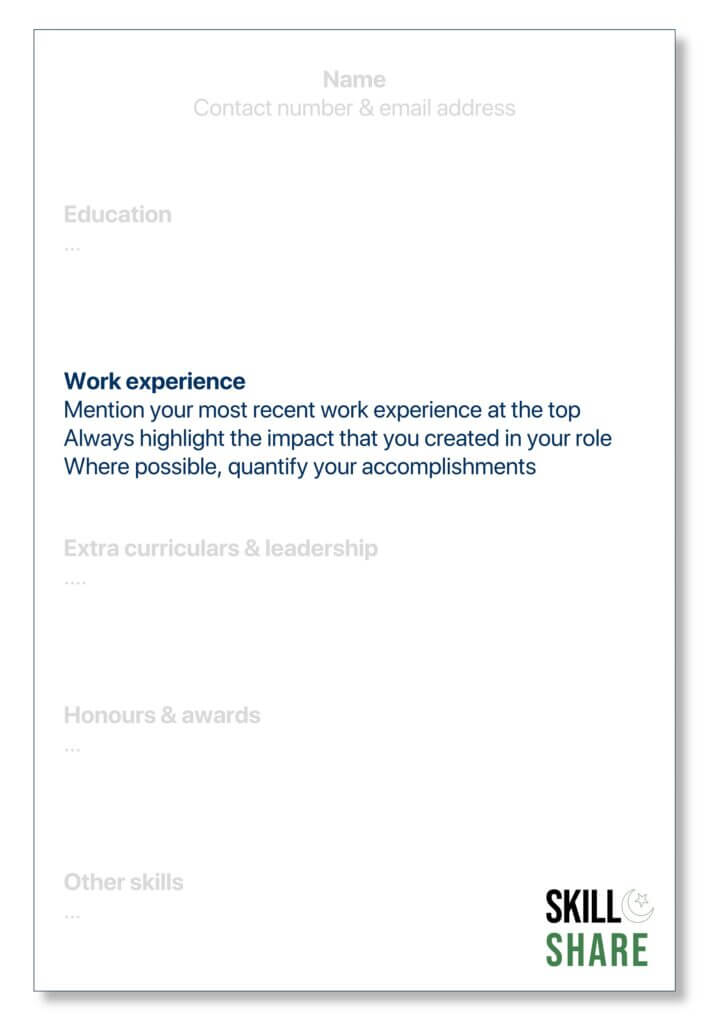
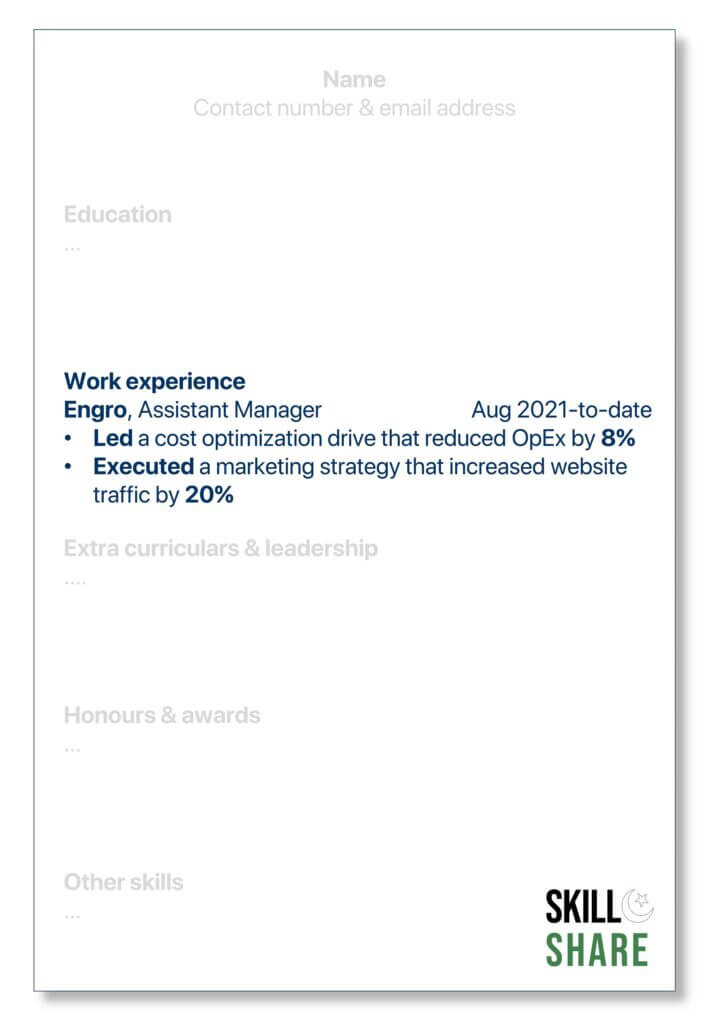
How to write a CV: Extracurriculars & Leadership
This is one of the minor content blocks on your CV, as mentioned above. These are essential additions that you do that will show the recruiter that there is more to you than just ‘professional work.’
The world is evolving constantly. which is why recruiters prefer dynamic and proactive individuals who have the spark and the ability to take initiative and really drive the company forward. Here, you should focus much more on impact and your leadership instead of focusing on mentioning as many things as possible. What people will look for is not that you have been part of many social organizations where you supported an event or did some minor activities. But instead, what you should really highlight and focus on here is the impact that you had. It’s your leadership at such an organization that will make you really stand out. So again, it’s okay to just mention two or three extracurricular roles in your CV, but focus on mentioning the specific things that you did and quantifying them.
For example,
- If you organized a conference, say how many people attended the conference.
- If you organized a fundraiser, mention the amount of money that you raised.
- If you led a social organization, mention how many people were part of that organization.
This is how you’ll show your leadership skills, and this is what volunteering is about: the impact that you have created. This is what will help you make your CV more effective and impressive.
You can see a few examples in the sample CV template below:
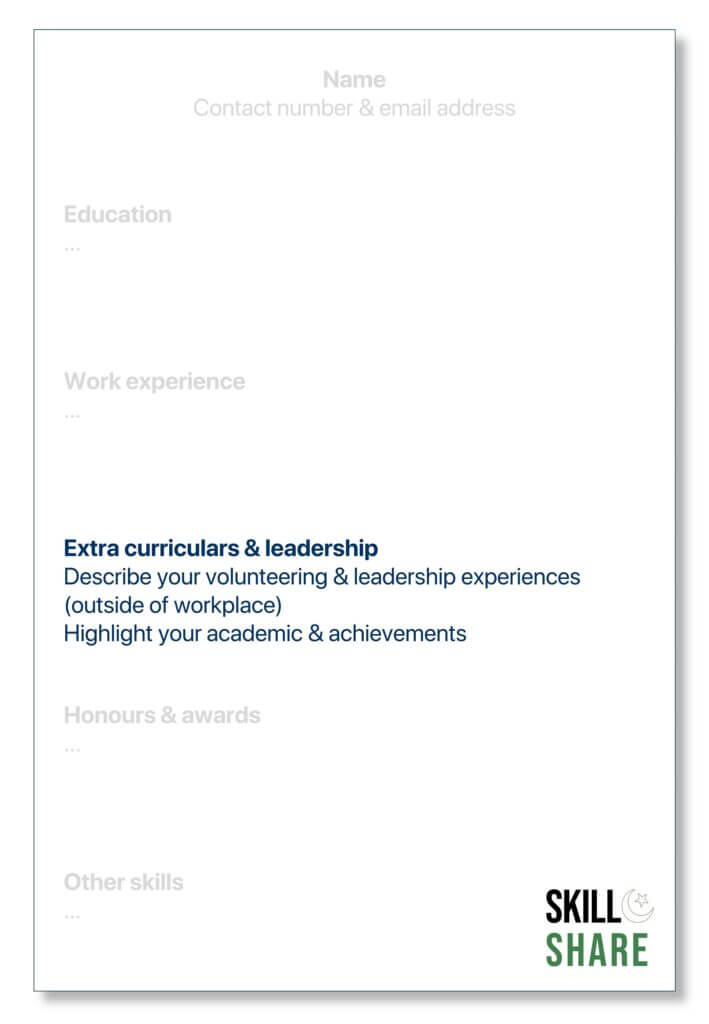
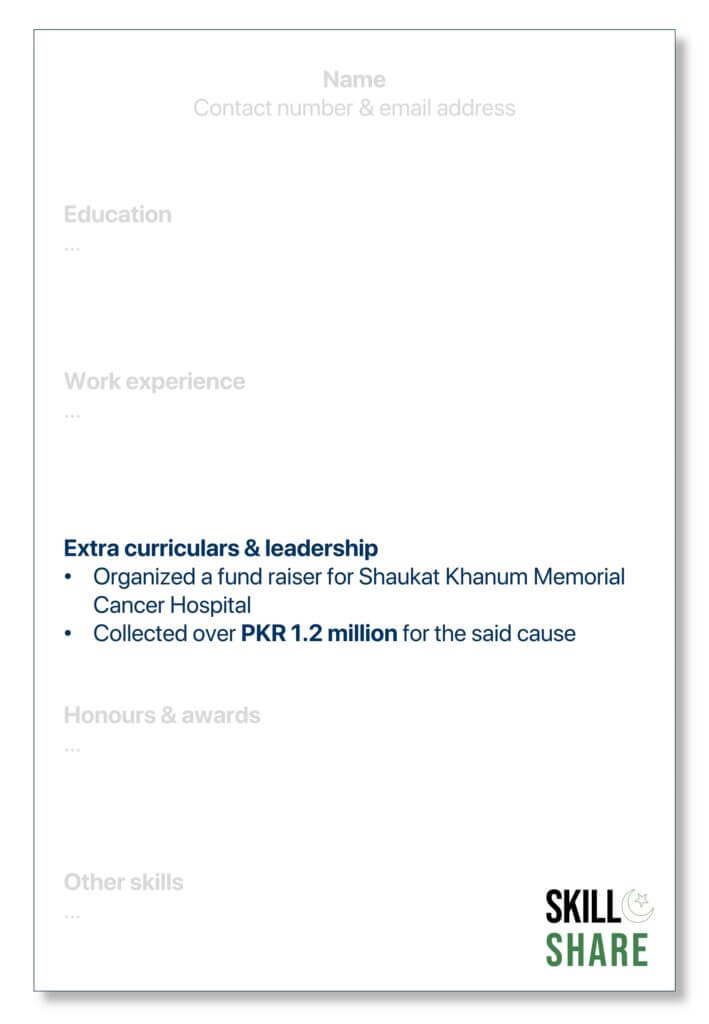
How to write a CV: Honours & Awards
As you write a CV, you can use the ‘honours and awards’ section to highlight your academic achievements, prizes, scholarships, dean list positions, and anything similar that will make you stand out. Moreover, you can also use this section to mention any publications that you have. Remember that you do not have to give too much detail, just briefly mention the title of your paper, and if anyone wants details, they can of course look it up.
Similarly, for academic achievements or scholarships, you don’t have to give a period every time. Instead, when writing your CV, simply include the heading “Scholarships” and list all scholarships you have received in a single line. This is much more effective and will save significant space on your CV.
Check out our sample CV template below to see how you can include honours and awards while making your CV.
You can see a few examples in the sample CV template below:
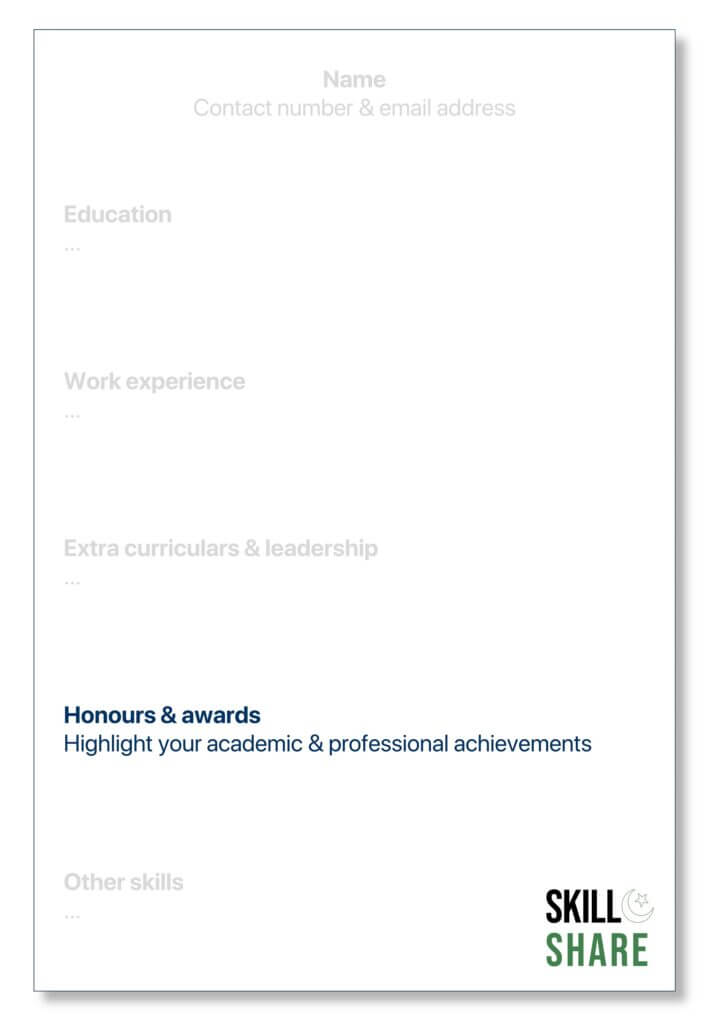
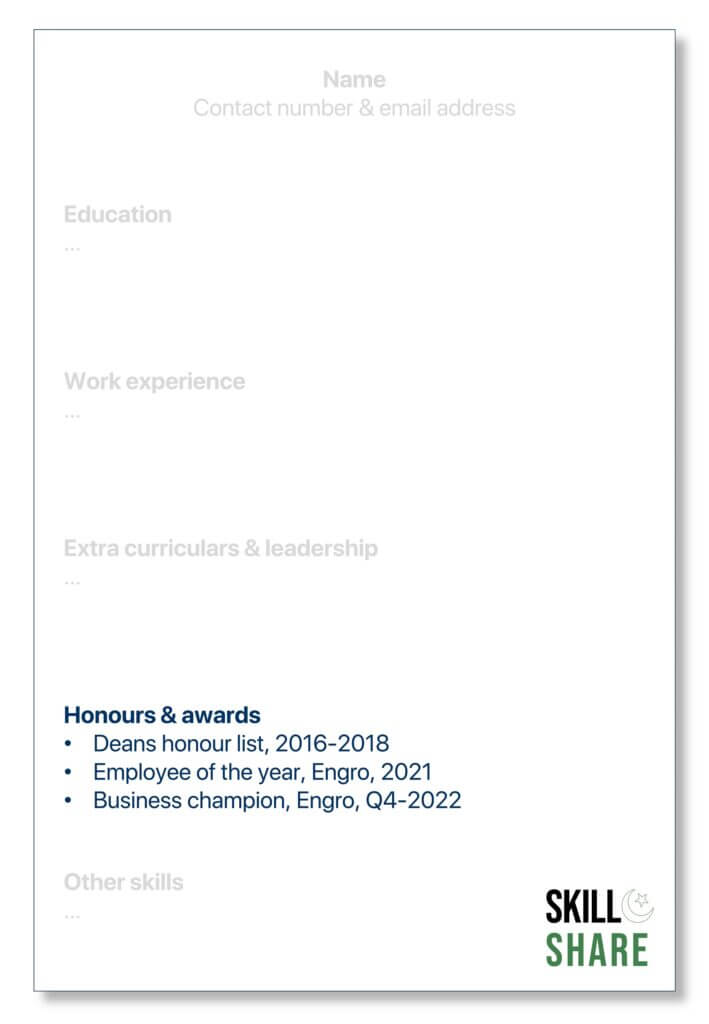
How to write a CV: Other Skills
The last section to include while you make a CV is that of other skills. You can mention all of your soft and hard skills here, which will just add a little more information about you as a candidate. For instance, if you are applying to a programming role, you can mention the programming languages that you can work with. Moreover, you can also mention other soft skills, such as problem-solving, market research, and other tools and software that you are proficient in. This can include Photoshop, STATA, Adobe Premiere Pro, etc.
A word of caution here is to avoid mentioning things that others just expect you to have. For example, there are cases where people mention they know how to operate windows. This is something you are just expected to know. Knowing how to operate Windows is not a big deal, and certainly not worth putting on your CV.
Here is a sample CV format to help you understand how you can cover this section while writing a CV:
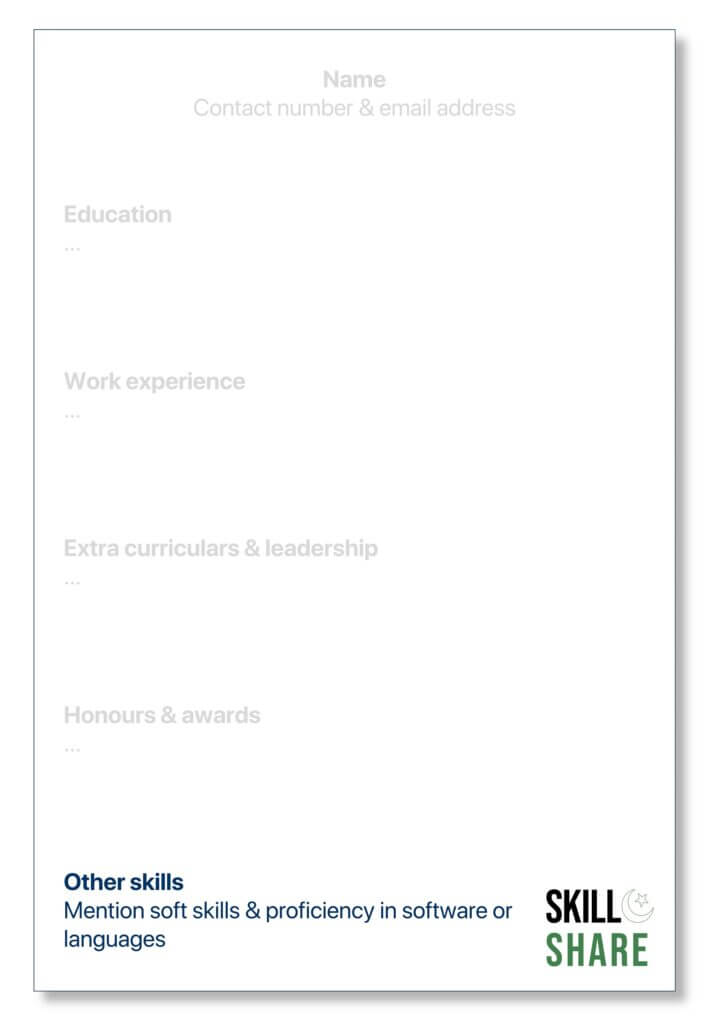
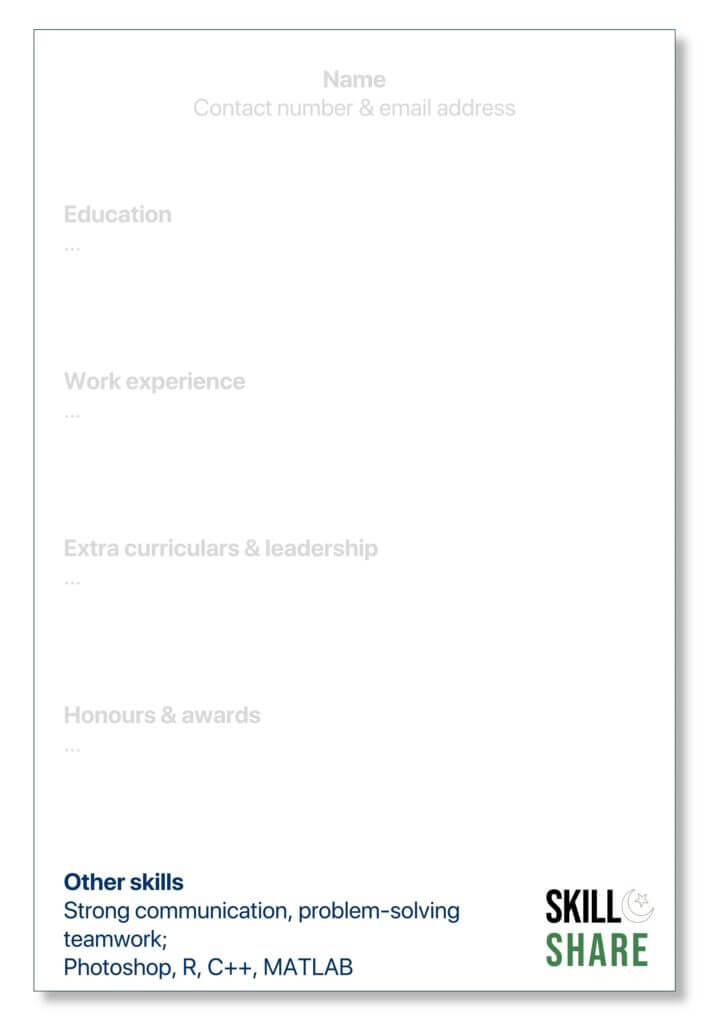
Sample CV Template
In this article, we discussed all the major and minor elements that you must capture in your CV. This comprehensive guide will really go a long way in helping you improve your resume and if you follow these tips, your CV will look much more impactful and impressive to the recruiter.
If you want to see more ideas on how to make your CV stronger, you can refer to our section on resume and CV writing where we will keep adding more blogs with regard to CV writing.
Meanwhile, here’s a CV template with all the key messages incorporated and notice how impressive it looks.
For now, we’ll wrap our article, and good luck while writing your own CVs.
